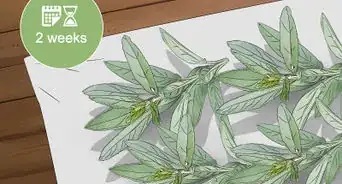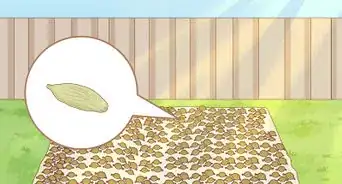This article was co-authored by wikiHow Staff. Our trained team of editors and researchers validate articles for accuracy and comprehensiveness. wikiHow's Content Management Team carefully monitors the work from our editorial staff to ensure that each article is backed by trusted research and meets our high quality standards.
There are 8 references cited in this article, which can be found at the bottom of the page.
The wikiHow Video Team also followed the article's instructions and verified that they work.
This article has been viewed 94,100 times.
Learn more...
Lemongrass is a staple of Thai cuisine and is commonly included in many popular Thai dishes. You can purchase bundles of 2–3 lemongrass stalks in large supermarkets and in any Asian market or grocery store. The grass itself is coarse and thick and needs to be prepared in a specific way before it can be used in food preparation. Once you’ve purchased the lemongrass, preparation shouldn’t take more than 15 minutes.
Steps
Trimming and Dicing Lemongrass
-
1Cut off the bottom 1⁄2 inch (1.3 cm) with a sharp kitchen knife. The lowest portion of the base of a lemongrass stalk is tough and flavorless. To remove it, place the lemongrass stalk on a cutting board. Then use a kitchen knife—such as a chef’s knife or a paring knife—to trim off the lowest 1⁄2 inch (1.3 cm). The base can be quite tough, so you might have to put substantial pressure on the knife.[1]
- Throw the base away once you’ve cut it off. Or if you prefer, add it to a compost pile in your backyard.
-
2Chop off the top 6–8 inches (15–20 cm) of the stalks. The dark green tops of the lemongrass stalks are also tough and chewy and generally lack flavor. Use your kitchen knife to cut off the tops of the stalk. Once you’ve removed both base and stalk, you should be left with a section of light-green lemongrass that’s only about 5–6 inches (13–15 cm) long.[2]
- Some grocery stores sell lemongrass with the green tops already removed. If this is the case for you, skip this step.
- If you’ve cut the tops off of the lemongrass stalks, you could hang on to them and use them to make lemongrass tea.[3]
Advertisement -
3Bisect the remaining lemongrass by slicing it from top to bottom. Align the knife blade so it runs vertically along the middle of the lemongrass stalk from top to bottom. Cut the stalk in half by applying pressure first to the tip of the blade and then rolling the blade back so its full length cuts through the lemongrass. You should have 2 even halves once you’ve made the cut.[4]
- Try to make the halves as even as you can to ensure that the lemongrass cooks evenly. The 2 halves don’t have to be perfectly equal, but if 1 is noticeably large than the other, it will take longer to cook.
-
4Press your thumbnail into the interior of the grass to find tender spots. If you look inside of the bisected lemongrass halves, you’ll notice that the lemongrass has multiple flaky layers and looks remarkably like a green onion. Only the most tender portions of the lemongrass are good to cook with. So, take 1 thumbnail and poke it into the inner and outer layers of the lemongrass to find the tender bits.[5]
- Also press your thumb along the thickly layered core of the bisected stalk. You’ll find that most of the base it too firm to eat.
-
5Remove the thick core and tough outer layers of the lemongrass. Take your kitchen knife and lop off the tough parts of the lemongrass core. On most stalks, you’ll end up cutting off about 2 inches (5.1 cm). Then peel away the tough outer layers of the lemongrass that can’t be easily marked with your thumbnail. In most cases, you’ll end up discarding 1 to 3 of the outer layers of the lemongrass stalks.[6]
- Repeat this process with the second lemongrass half. You should need to remove roughly the same amount of the core and outer layers on both stalks.
-
6Dice the remaining lemongrass stalk into 1⁄4 inch (0.64 cm) pieces. The 2 small lemongrass stalk halves that you’re left with should be tender and edible. Lay 1 half flat on the cutting board and use your knife to slice it into small pieces. Rather than lifting up your knife and moving it after every cut, just slide the lemongrass under the knife blade. Each of the sections you cut should only be 1⁄4–1⁄8 inch (0.64–0.32 cm) long.[7]
- Dice the second lemongrass stalk as well. Be careful not to nick your fingers with the chef’s knife.
- At this point, the lemongrass is completely cut and ready to be used in dishes of your choosing!
-
7Store the diced lemongrass in your fridge for up to 3 weeks. If you’re not going to eat all of the lemongrass right away, seal the leftover pieces in a plastic bag. Set the bag in your refrigerator in a location where it will be visible and you won’t forget about it. While most lemongrass will still be good for 3 weeks, cut-up stalks that were old when you bought them may only be edible for 2 weeks.[8]
- If you don’t have a plastic bag on hand, you can wrap the leftover lemongrass in a piece of thin plastic cling wrap.
-
8Freeze lemongrass for up to 6 months for long-term usage. As with the diced lemongrass, freeze cut lemongrass in an air-tight bag. Keeping cut lemongrass in the freezer is a good option if you’re planning to cook many Thai dishes over a long period of time and don’t want to be cutting lemongrass multiple times a week.[9]
- Remember to mark the date on the bag so you know when you froze it. Write something like: “Diced lemongrass May 1 2019.”
Selecting Lemongrass Stalks
-
1Smell the lemongrass stalks to select the most fragrant. More fragrant lemongrass stalks will also have more flavor. Don’t be shy about it—pick up a bundle and take a big sniff of the base and the stalk. Good bundles should have an aromatic aroma with a slight hint of lemon. Some people find that fresh lemongrass even has a slightly soapy smell.
- While many supermarkets do sell pre-cut lemongrass stalks that have been diced into small cubes, you’re better off leaving these on the shelf. Pre-cut lemongrass has usually lost most of its potent flavor.
-
2Look for stalks with light-green bases and darker green tips. The base of a stalk of lemongrass looks a little like the base of green onions or shallots. The bases of the healthiest and most flavorful lemongrass stalks will have a pale greenish-white tint. As the base splits off into multiple stalks, the green color should darken. This is a good indicator that the stalk is fresh and flavorful.
- If the entire length of the stalk is light green, it probably won’t have much flavor and may be on its way to going bad.
-
3Find stalks that are clumped tightly together and firm to the touch. On healthy lemongrass, the multiple stalks growing out of the base should be tightly packed together. There should not be any visible gaps between the stalks. This is a sign of the lemongrass’s freshness and so indicates that the grass will taste good.[10]
- If stalks seem to be falling apart or feel loose and mushy to the touch, they’re probably not in great condition and won’t taste very good.
Things You’ll Need
- 1 bundle of lemongrass
- kitchen knife
- cutting board
- plastic bags (optional)
- plastic container (optional)
- permanent marker (optional)
- compost bin (optional)
References
- ↑ https://youtu.be/exe3Aa1d7Ro?t=26
- ↑ https://youtu.be/exe3Aa1d7Ro?t=42
- ↑ https://www.finecooking.com/ingredient/lemongrass
- ↑ https://youtu.be/exe3Aa1d7Ro?t=52
- ↑ https://youtu.be/exe3Aa1d7Ro?t=74
- ↑ https://youtu.be/exe3Aa1d7Ro?t=78
- ↑ https://youtu.be/exe3Aa1d7Ro?t=96
- ↑ https://www.finecooking.com/ingredient/lemongrass
- ↑ https://www.hobbyfarms.com/how-to-harvest-lemongrass/































































